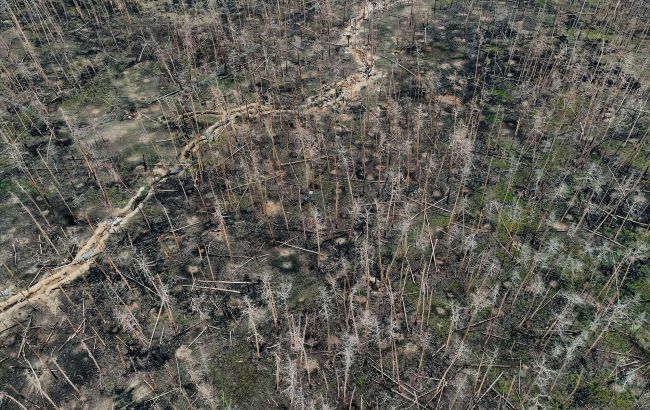War webs Serebrianskyi Forest: Drones trail fiber‑optic cables across battlefield
 Ukrainian Armed Forces show how war has changed the legendary Serebrianskyi Forest (photo: GettyImages)
Ukrainian Armed Forces show how war has changed the legendary Serebrianskyi Forest (photo: GettyImages)
Russian forces continue their assaults on the Serebrianskyi forestry, which begins near Kreminna and stretches over 107 hectares to the administrative border with the Donetsk region. The 63rd Separate Mechanized Brigade of the Ukrainian Armed Forces published a corresponding video.
"This is what the legendary Serebrianskyi Forest now looks like in the area of responsibility of the 63rd Brigade – completely covered in fiber-optic cables from drones. Just imagine how many of them are flying here. And what this landscape will look like after the war," the video is captioned.
The footage shows what appears to be the forest covered in a strange web. In reality, it's a fiber-optic cable used for drones.
Ukraine and Russia are actively developing strike drones using fiber-optic technology. These have several advantages, particularly in extending drone range, which could soon reach 30–50 kilometers.
What is known about the Serebrianskyi Forest
The Serebrianskyi Forest, also known as the Kreminna Forest or, as Ukrainian soldiers call it, the "Forest of Wonders," is located near the city of Kreminna. Part of it is a local botanical reserve managed by the state-run Kreminna Forestry and Hunting Enterprise.
This mostly pine forest begins right on the outskirts of Kreminna and stretches more than 107 hectares to the administrative border with the Donetsk region. In the fall of 2022, six months after the occupation of Kreminna, Russian forces began active assaults on this area.
It became clear at that time that Russia's blitzkrieg strategy had failed, and the Kremlin shifted its focus to establishing control over the borders of the Donetsk and Luhansk regions. In this context, the Serebrianskyi Forest gained strategic significance for the Russian army. The enemy constantly tries to push Ukrainian forces out of the forest, and fierce fighting continues there.
Fiber-optic drones in the war
Drones equipped with fiber-optic communication are becoming increasingly crucial in the Russia–Ukraine war, especially in light of heavy use of electronic warfare (EW) tools that jam radio signals and GPS.
Unlike conventional drones, these transmit images and receive commands not through radio channels, but via ultra-thin fiber-optic cables that unwind from a spool during flight.
In April, the defense cluster Brave1 successfully tested domestically developed FPV drones with fiber-optic control systems that can operate at distances over 20 kilometers. Fifteen Ukrainian developers took part in the tests, showcasing their technical solutions.
Ukraine is also working to disrupt Russia's fiber-optic drone production. In May, a fiber-optic systems plant in Saransk came under attack. The Russian facility was seriously damaged, and discussions reportedly began about a complete shutdown.

